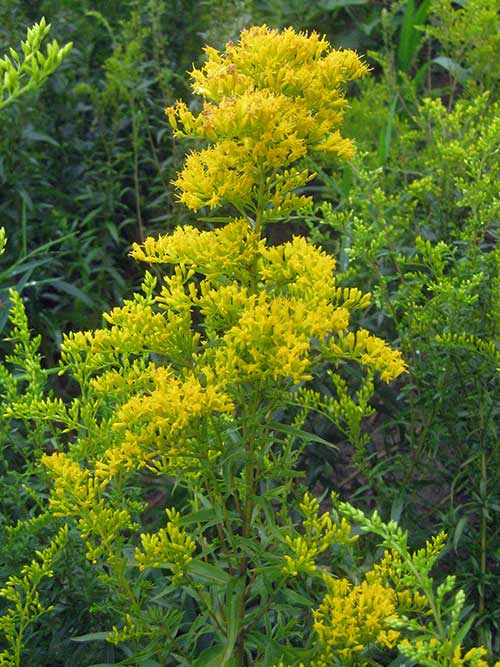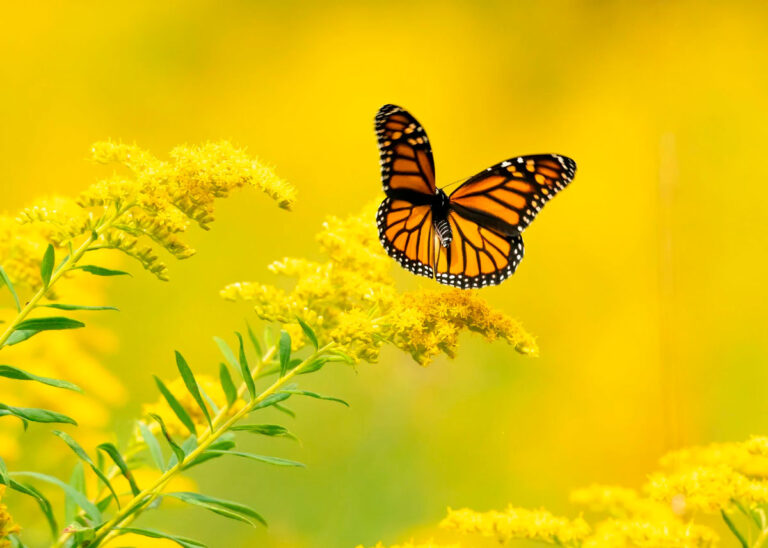Allergy sufferers often curse the golden sea of blooms from goldenrods that appear in fallow fields, landscapes and along roadsides from July to November. Sadly, these complaints are based on an unfortunate case of mistaken identity.

Both members of the aster family (Asteraceae), goldenrods (Solidago genus) are often errantly identified as allergenic ragweeds (Ambrosia genus). Though there are similarities in height and general appearance, the ragweed has dull white flowers that are typically not showy, while the goldenrod’s flowers are almost always a brilliant yellow or gold color and paint the landscape with their brilliance. The source of ragweed’s allergenic nature – airborne pollen – is not possible for the goldenrod, whose heavy pollen must be transported by pollinating insects. Hence the true ecological importance of goldenrods as a vital source of pollen and nectar for native bees, honeybees, butterflies and other pollinators late in the summer and into the fall months when other sources are scarce.
We typically associate the monarch butterfly with the milkweeds (Asclepia genus) because they are the only plants on which a monarch’s larvae can feed. But goldenrods and, to a lesser extent, the similarly late-blooming asters and others are crucial sources of nectar for adult monarch butterflies as they migrate south from their summer homes in Canada and the United States to their wintering grounds in Mexico during months when other flowering species are scarce or no longer in bloom.
This fact alone makes a strong case for including goldenrod species in landscapes, pollinator gardens, ecological restorations, golf course out-of-play areas, and anywhere native plants are being used in biodiverse seed mixes.

In addition to their incredibly high pollinator forage value, goldenrods can hold their own as landscape design candidates based on a host of other aesthetic and functional factors.
Typically considered upland species, much of the goldenrod family is adaptable to moderately wet conditions as well, lending themselves well to use in meadows, pollinator gardens and even along well-drained buffers with waterways and wetlands. It’s always a good idea to research the many different goldenrod species and their unique growth habits and conditions to ensure the best choice for your site’s unique characteristics. Our Seed Finder Tool allows you to narrow your search based on a host of user-defined criteria.
The goldenrod’s stature lends vertical structure to designed landscapes. The shortest of the goldenrods sold at Ernst Conservation Seeds, Riddell’s goldenrod (Solidago riddellii), reaches a maximum height of just 4 feet, while wrinkleleaf goldenrod (Solidago rugosa), tops-out at just over 8 feet.
As its name implies licorice-scented goldenrod (Solidago odora) exhibits a pleasant anise scent when its leaves are crushed. This showy, mid-height (about five feet) goldenrod blooms from July through September and thrives in dry open woods and sandy soils.

Goldenrod greens provide nutrition for the eastern cottontail, whitetail deer, various voles, the Allegheny woodrat, woodchucks and ruffed and sharp-tailed grouse. Its seeds are a favorite of numerous grassland birds and songbirds like the goldfinch (and other finches), dark-eyed junco, indigo and snow bunting, redpolls and pine siskins, just to name a few.
When the winter winds blow and snow drapes the landscape in most of the northern states, goldenrods left un-mowed will eventually bow under the weight of the snow mantle and create additional movement corridors for upland game birds and small mammals, while their remaining seeds provide a continued food source for over-wintering birds.
Regardless what your individual motivations are when choosing native plant species, be sure to consider the ecological, environmental and aesthetic potential goldenrods bring to the equation.

